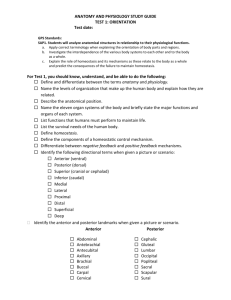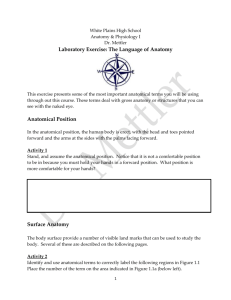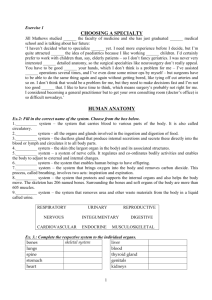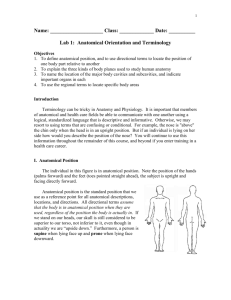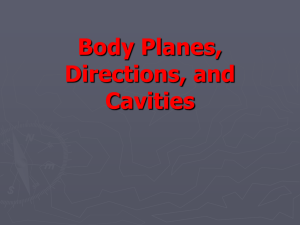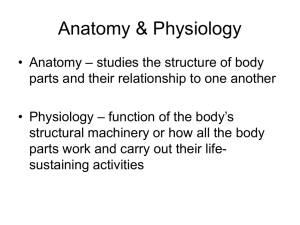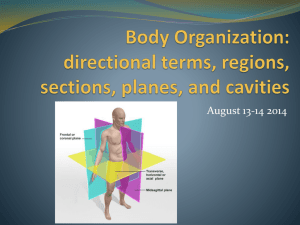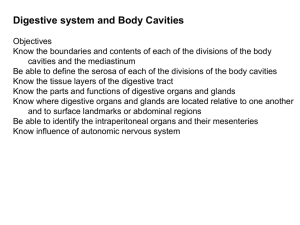bioii anatomical position & terminology
advertisement
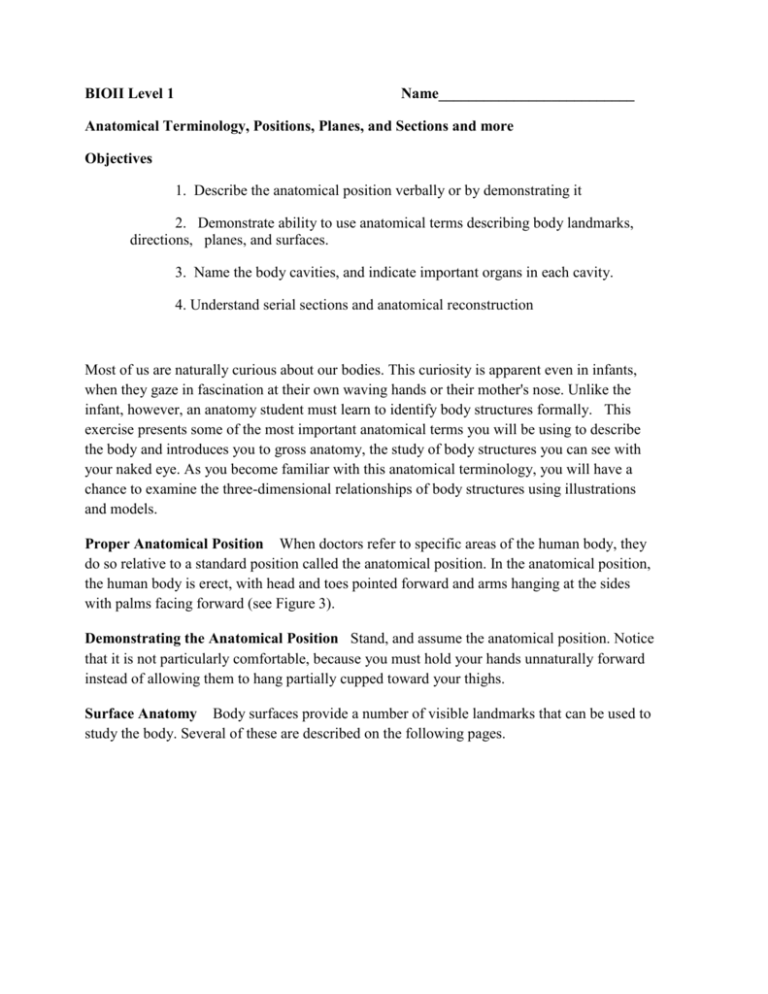
BIOII Level 1 Name__________________________ Anatomical Terminology, Positions, Planes, and Sections and more Objectives 1. Describe the anatomical position verbally or by demonstrating it 2. Demonstrate ability to use anatomical terms describing body landmarks, directions, planes, and surfaces. 3. Name the body cavities, and indicate important organs in each cavity. 4. Understand serial sections and anatomical reconstruction Most of us are naturally curious about our bodies. This curiosity is apparent even in infants, when they gaze in fascination at their own waving hands or their mother's nose. Unlike the infant, however, an anatomy student must learn to identify body structures formally. This exercise presents some of the most important anatomical terms you will be using to describe the body and introduces you to gross anatomy, the study of body structures you can see with your naked eye. As you become familiar with this anatomical terminology, you will have a chance to examine the three-dimensional relationships of body structures using illustrations and models. Proper Anatomical Position When doctors refer to specific areas of the human body, they do so relative to a standard position called the anatomical position. In the anatomical position, the human body is erect, with head and toes pointed forward and arms hanging at the sides with palms facing forward (see Figure 3). Demonstrating the Anatomical Position Stand, and assume the anatomical position. Notice that it is not particularly comfortable, because you must hold your hands unnaturally forward instead of allowing them to hang partially cupped toward your thighs. Surface Anatomy Body surfaces provide a number of visible landmarks that can be used to study the body. Several of these are described on the following pages. Locating Body Landmarks: Identify and use anatomical terms to correctly label the following regions on the figure below Anterior Body Landmarks Abdominal: The anterior body trunk region inferior to the ribs Antecubital: The anterior surface of the elbow Axillary: The armpit Brachial: The arm Buccal: The cheek Carpal: The wrist Cervical: The neck region Coxal: The hip Deltoid: The roundness of the shoulder caused by the underlying deltoid muscle Digital: The fingers or toes Femoral: The thigh Fibular: The side of the leg Posterior Body Landmarks Cephalic: The head Gluteal: The buttocks or rump Lumbar: area of the back between ribs and hips; loin Occipital: The posterior aspect of the head or base of the skull Body Orientation and Direction Inguinal: The groin Mammary: The breast Manus: The hand Nasal: The nose Oral: The mouth Orbital: The bony eye socket (orbit) Patellar: The anterior knee (kneecap) region Pelvic: The pelvis region Pubic: The genital region Sternal: The region of the breastbone Tarsal: The ankle Thoracic: The chest Umbilical: The navel Popliteal: The back of the knee Sacral: The area between the hips Scapular: The scapula or shoulder blade area Sural: The calf or posterior surface of the leg Vertebral: The area of the spinal column Study the terms below, referring to Figure 2. Notice as you read that certain terms have a different meaning for a four-legged animal than they do for a human. Superior/inferior (above/below): These terms refer to the location of a structure along the long axis of the body. Superior structures appear above other structures, and inferior structures are always below other body parts. Anterior/posterior (frontlback): In humans the most anterior structures are those that are most forward-the face, chest, and abdomen. Posterior structures are those toward the backside of the body. Medial/lateral (toward the midline/away from the midline or median plane): Medial structures are closer to the body midline than are lateral structures. The terms described above assume the person is in the anatomical position. The next four pairs of terms are more absolute. They do not relate to a particular body position, and they have the same meaning in all vertebrate animals. Cephalad/caudad (caudal) (toward the head/toward the tail): In humans these terms are used interchangeably with superior and inferior. But in four-legged animals, they are synonyms of anterior and posterior, respectively. Dorsal/ventral (backsidelbelly side): Meaning "back," the term dorsal refers to the animal's back or the backside of any other structures. The term ventral, meaning "belly," always refers to the belly side of animals. In humans the terms ventral and dorsal are used interchangeably with the terms anterior and posterior, but in four-legged animals ventral and dorsal mean inferior and superior, respectively. Proximal/distal (nearer the trunk or attached end/farther from the trunk or point of attachment): These terms locate various areas along the body limbs or an elongated organ such as the intestine. For example, the fingers are distal to the elbow; the knee is proximal to the toes. Superficial/deep (toward or at the body surface/away from the body surface or more internal): These terms locate body organs according to their relative closeness to the body surface. For example, the skin is superficial to the skeletal muscles. Practice Using Correct Anatomical Terminology Before continuing, use a human torso model, a skeleton, or your own body to specify the relationship between the following structures. 1. The wrist is________________ to the hand. 2. The trachea (windpipe)is______________ to the spine. 3. The brain is________________ to the spinal chord. 4. The kidneys are_________________ to the liver. 5. The nose is to_______________ the cheek bones. 6. The chest is_____________________ to the abdomen. 7. The skin is____________________ to the skeleton. Body Planes and Sections The body is three-dimensional. So, to observe its internal parts, it often helps to make use of a section, or cut made along an imaginary surface or line called a plane. There are three planes (Figure 3), or sections, that lie at right angles to one another. Sagittal plane: A plane that runs lengthwise or longitudinally down the length of the body, dividing it into right and left parts, is a sagittal plane. If it divides the body into equal parts, down the midline of the body, it is called a median, or midsagittal, plane. Frontal (coronal) plane: A longitudinal plane that divides the body (or an organ) into anterior and posterior parts. Transverse plane: A plane that runs horizontally, dividing the body into superior and inferior parts. These sections are also commonly called cross sections. Body Cavities The axial portion of the body has two main cavities Dorsal Body Cavity The dorsal body cavity consists of the cranial and spinal cavities. The cranial cavity, within the rigid skull, contains the brain. The spinal cavity, which runs within the bony vertebral column, protects the spinal cord. The spinal cord is a continuation of the brain, and the cavities containing them are continuous with each other. Ventral Body Cavity Like the dorsal cavity, the ventral body cavity is subdivided. The superior thoracic cavity is separated from the rest of the ventral cavity by the muscular diaphragm. The heart and lungs, located in the thoracic cavity, are protected by the bony rib cage. The cavity inferior to the diaphragm is the abdominopelvic cavity. Although there is no further physical separation of this part of the ventral cavity, some describe the abdominopelvic cavity in terms of a superior abdominal cavity, the area that houses the stomach, intestines, liver, and other organs, and an inferior pelvic cavity, which is partially enclosed by the bony pelvis and contains the reproductive organs, bladder, and rectum. Notice that the pelvic cavity tips away from the abdominal cavity in a posterior direction Abdominopelvic Quadrants and Regions Body cavities The abdominopelvic cavity is quite large and contains many organs, so it is helpful to divide it up into smaller areas for study. The medical scheme divides the abdominal surface (and the abdominopelvic cavity deep to it) into four approximately equal regions called quadrants, named according to their relative positionthey are, right upper quadrant, right lower quadrant, left upper quadrant, and left lower quadrant Another scheme, commonly used by anatomists, divides the abdominal surface and abdominopelvic cavity into nine separate regions by four planes, also shown in Figure 6. Although the names of these nine regions are unfamiliar to you now, with a little patience and study, they will become easier to remember. These regions are: Umbilical region: The centermost region, which includes the umbilicus. Epigastric region: Immediately superior to the umbilical region; overlies most of the stomach. Hypogastric (pubic) region: Immediately inferior to the umbilical region; encompasses the pubic area. Iliac regions: Lateral to the hypogastric region and overlying the superior parts of the hip bones. Lumbar regions: Between the ribs and the flaring portions of the hip bones; lateral to the umbilical region. Hypochondriac regions: Flanking the epigastric region laterally and overlying the lower ribs. ACTIVITY Read through the descriptions of these nine regions locate them in Figure 6. Be sure to notice the organs they contain. Figure 6. Abdominopelvic surface and cavity.
